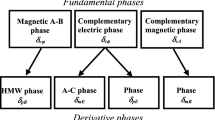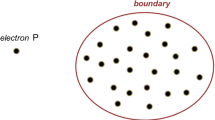Abstract
The Aharonov–Bohm effect is a genuine quantum effect typically characterized by a measurable phase shift in the wave function for a charged particle that encircles an electromagnetic field located in a region inaccessible to the particle. However, this definition is not possible in the majority of the phase-space descriptions since they are based on quasiprobability distributions. In this work, we characterize for the first time the Aharonov–Bohm effect within two different formalisms of quantum mechanics. One of them is the phase-space formalism relying on the canonical commutation relations and Weyl transform. In this framework, the aim is to obtain a consistent description of the quantum system by means of the quasiprobability Wigner function. The other one is the Segal–Bargmann formalism, which we mathematically describe and connect with quantum mechanics by means of the commutation relations of the creation and annihilation operators. After an introduction of both formalisms, we study the Aharonov–Bohm effect within them for two specific cases: one determined by a non-zero electric potential, and another determined by a non-zero magnetic vector potential. Subsequently, we obtain a more general description of the Aharonov–Bohm effect that encompasses the two previous cases and that we prove to be equivalent to the well-known description of this effect in the usual quantum mechanics formalism in configuration space. Finally, we delve into the Aharonov–Bohm effect, employing a density operator to depict states with positional and momentum uncertainty, showcasing its manifestation through distinctive interference patterns in the temporal evolution of Wigner functions under an electric potential, and emphasizing the intrinsically quantum nature of this phenomenon.






Similar content being viewed by others
Data Availability Statement
This manuscript has no associated data or the data will not be deposited. [Authors’ comment: Data sharing not applicable to this article as no datasets were generated or analysed during the current study.]
Notes
It must be emphasized that plane waves are a pathological case when normalized. However, we will use them since they allow us to simplify the discussion of the Aharonov–Bohm effect.
It is supposed that the activation and disconnection processes will not affect the particle evolution.
We should remember that the Segal–Bargmann space has been built with dimensionless variables, so the wave function must be expressed in terms of these variables.
This property may actually be posed as the commutation relation \([{\hat{P}}-qA,{\hat{M}}]\), which implies that it is fulfilled in all formalisms.
We do not include the condition \(\text {Tr}[{\hat{\rho }}]=1\) because it is related to the norm of the state. Once again, we are taking a non-normalizable state as a simple limit of a normalizable one.
Note that we have removed a global factor \(1/2\pi \) since it is irrelevant due to the non-normalizability of the Wigner function.
When \(q\Delta \varphi \cdot \uptau =\pi /2+2\pi n\) with \(n\in {\mathbb {Z}}\) and \(t>\uptau \), the maximum contours of the oscillation background become minimum and vice versa.
References
W. Ehrenberg, R.E. Siday, The refractive index in electron optics and the principles of dynamics. Proc. Phys. Soc. Sect. B 62(1), 8 (1949)
Y. Aharonov, D. Bohm, Significance of electromagnetic potentials in the quantum theory. Phys. Rev. 115(3), 485 (1959)
A. Tonomura, T. Matsuda, R. Suzuki, A. Fukuhara, N. Osakabe, H. Umezaki, J. Endo, K. Shinagawa, Y. Sugita, H. Fujiwara, Observation of Aharonov–Bohm effect by electron holography. Phys. Rev. Lett. 48, 1443–1446 (1982). https://doi.org/10.1103/PhysRevLett.48.1443
A. Tonomura, The Aharonov–Bohm effect and its applications to magnetic field observation. Asia Pacific Phys. Newsl. 2(01), 26–36 (2013)
F. De Juan, A. Cortijo, M.A. Vozmediano, A. Cano, Aharonov–Bohm interferences from local deformations in graphene. Nat. Phys. 7(10), 810–815 (2011)
W. Heisenberg, Uber den anschaulichen inhalt der quantentheoretischen kinematik und mechanik. Z. Angew. Phys. 43(3–4), 172–198 (1927)
E. Wigner, On the quantum correction for thermodynamic equilibrium. Phys. Rev. 40, 749–759 (1932). https://doi.org/10.1103/PhysRev.40.749
H. Weyl, Quantenmechanik und gruppentheorie. Z. Physik 46, 1–46 (1927). https://doi.org/10.1007/BF02055756
H.J. Groenewold, On the principles of elementary quantum mechanics. Physica 12(7), 405–460 (1946). https://doi.org/10.1016/S0031-8914(46)80059-4
J.E. Moyal, Quantum mechanics as a statistical theory. Math. Proc. Camb. Philos. Soc. 45(1), 99–124 (1949). https://doi.org/10.1017/S0305004100000487
T. Takabayasi, Remarks on the formulation of quantum mechanics with classical pictures and on relations between linear scalar fields and hydrodynamical fields. Progress Theor. Phys. 9(3), 187–222 (1953). https://doi.org/10.1143/ptp/9.3.187
G.A. Baker, Formulation of quantum mechanics based on the quasi-probability distribution induced on phase space. Phys. Rev. 109, 2198–2206 (1958). https://doi.org/10.1103/PhysRev.109.2198
D.B. Fairlie, The formulation of quantum mechanics in terms of phase space functions. Math. Proc. Camb. Philos. Soc. 60(3), 581–586 (1964). https://doi.org/10.1017/S0305004100038068
R. Kubo, Wigner representation of quantum operators and its applications to electrons in a magnetic field. J. Phys. Soc. Jpn. 19(11), 2127–2139 (1964). https://doi.org/10.1143/JPSJ.19.2127
E.C.G. Sudarshan, Equivalence of semiclassical and quantum mechanical descriptions of statistical light beams. Phys. Rev. Lett. 10, 277–279 (1963). https://doi.org/10.1103/PhysRevLett.10.277
R.J. Glauber, Coherent and incoherent states of the radiation field. Phys. Rev. 131, 2766–2788 (1963). https://doi.org/10.1103/PhysRev.131.2766
K. Husimi, Some formal properties of the density matrix. Proc. Physico-Math. Soc. Japan 22(4), 264–314 (1940)
H.-W. Lee, Theory and application of the quantum phase-space distribution functions. Phys. Rep. 259(3), 147–211 (1995). https://doi.org/10.1016/0370-1573(95)00007-4
C.K. Zachos, D.B. Fairlie, T.L. Curtright, Quantum Mechanics in Phase Space (World Scientific, Singapore, 2005). https://doi.org/10.1142/5287
C. Zachos, D. Fairlie, T. Curtright, Quantum mechanics in phase space: an overview with selected papers (2005)
V. Bargmann, On a Hilbert space of analytic functions and an associated integral transform part I. Commun. Pure Appl. Math. 14(3), 187–214 (1961)
I.E. Segal, G.W. Mackey, Mathematical Problems of Relativistic Physics, vol. 2 (American Mathematical Society, New York, 1963)
B.C. Hall, Holomorphic Methods in Mathematical Physics (1999). https://doi.org/10.48550/ARXIV.QUANT-PH/9912054
F. Galindo Soto, L.A. Tristán Vega, J. Sanz Gil, J. Gómez Pérez, A. Lastra Sedano, J.J. Jiménez Garrido, et al. Guía teórico-práctica de variable compleja para estudios de grado (2015)
V.J. Neumann, Die eindeutigkeit der schrödingerschen operatoren. Mathematische Annalen 104(1), 570–578 (1931)
J. Rosenberg, A selective history of the Stone-von Neumann theorem. Contemp. Math. 365, 331–354 (2004)
J. José, E. Saletan, Classical Dynamics: A Contemporary Approach (American Association of Physics Teachers, New York, 2000)
C. Wittig, Lecture Notes on Quantum Chemistry, Aharonov–Bohm Effect and Geometric Phase
Acknowledgements
This work was partially supported by the MICINN (Spain) project PID2019-107394GB-I00/ AEI/10.13039/501100011033 (AEI/FEDER, UE) and PID2022-139841NB-I00, COST (European Cooperation in Science and Technology) Actions CA21106 and CA21136. JARC acknowledges support by Institut Pascal at Université Paris-Saclay during the Paris-Saclay Astroparticle Symposium 2022, with the support of the P2IO Laboratory of Excellence (program “Investissements d’avenir” ANR-11-IDEX-0003-01 Paris-Saclay and ANR-10-LABX-0038) and the P2I axis of the Graduate School of Physics of Université Paris-Saclay, as well as IJCLab, CEA, APPEC, IAS, OSUPS, and the “IN2P3 master projet UCMN”.
Author information
Authors and Affiliations
Contributions
All authors contributed equally to the study conception and design. Material preparation and analysis were performed by all authors. The first draft of the manuscript was written cooperatively, and all authors commented on previous versions of the manuscript. All authors read and approved the final manuscript.
Corresponding author
Rights and permissions
Springer Nature or its licensor (e.g. a society or other partner) holds exclusive rights to this article under a publishing agreement with the author(s) or other rightsholder(s); author self-archiving of the accepted manuscript version of this article is solely governed by the terms of such publishing agreement and applicable law.
About this article
Cite this article
Cembranos, J.A.R., García-López, D. & del Toro, Z.G. Aharonov–Bohm effect in phase space. Eur. Phys. J. D 78, 16 (2024). https://doi.org/10.1140/epjd/s10053-024-00804-y
Received:
Accepted:
Published:
DOI: https://doi.org/10.1140/epjd/s10053-024-00804-y




